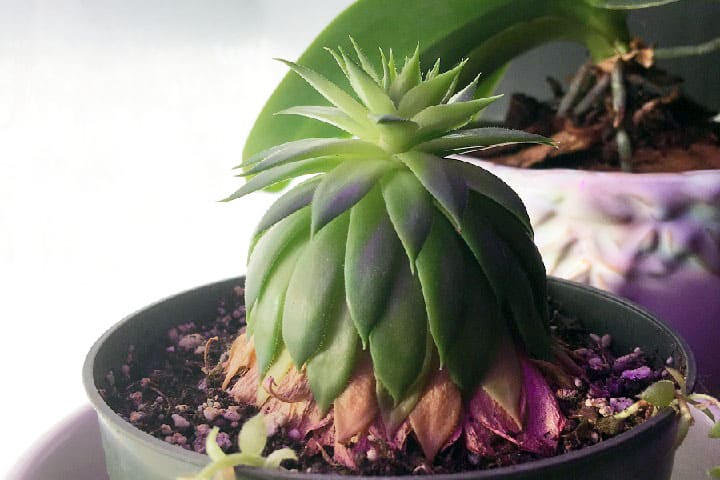Hens and Chicks Growing Tall: What’s Really Happening
Have you ever wondered why your hens and chicks suddenly start growing tall? It all boils down to a lack of light. Insufficient sunlight can cause these delightful plants, particularly those with a rosette shape like sempervivums, echeverias, graptoverias, and similar succulents, to elongate and lose their original stunning form.
Etiolation, as it is scientifically known, is an incredibly common issue among succulent enthusiasts. In this blog post, we delve into the prevention of stretching and offer solutions on how to rectify an already etiolated hens and chicks succulent. Get ready to unravel the secrets behind maintaining your hens and chicks’ natural beauty and vitality.

Contents
Hens and Chicks Growing Tall
A while back, I received an email from Sarah, a concerned reader who noticed her sempervivum succulent growing tall and displaying drooping leaves. This is a common occurrence, particularly when cultivating Sempervivum indoors.
As we know, succulent plants are slow growers by nature. Usually, rosette-shaped succulents maintain a proportional growth pattern in relation to their width and length. However, when these plants fail to receive an adequate amount of sunlight, they can stretch rapidly in an effort to seek more light. This phenomenon is scientifically referred to as etiolation.
In botanical terms, etiolation refers to the process of seed or plant growth under low light conditions. It is characterized by a lack of chlorophyll, limited development of chloroplasts, increased distance between nodes, and reduction in lignification—the hardening of plant tissues.
Understanding the Causes of Stretching in Hens and Chicks
Sempervivums, like other succulents, stretch when deprived of sufficient sunlight, resulting in accelerated growth. Initially, you may notice the plant bending toward the light source. This is soon followed by its elongation, manifesting as increased height and greater spacing between leaves. In addition, the leaves may become smaller and exhibit lighter hues due to chlorophyll deficiency.
Initially, the succulent may not show signs of illness and will continue to grow. However, if the lack of light persists for an extended period, the plant’s health will gradually decline, potentially resulting in its demise within a few months.
Resolving the Dilemma: Correcting a Tall Sempervivum
Once a sempervivum has stretched, it is impossible to restore its original compact shape. However, fret not, as there is a solution—indeed, this situation can even be turned to our advantage.
To rectify the issue, we need to carefully trim the top portion of the hens and chicks plant using sharp scissors. Leave around one to two inches of stem intact for replanting. At the base (where the roots are), ensure that a few leaves remain to facilitate sun exposure and respiration. Although succulents can sprout from bare stems, the presence of some leaves can aid in the process.
While I personally do not typically allow the stems to dry before replanting to promote wound healing, it is advisable to do so to prevent infections. Therefore, I must recommend drying the stems for a few days. Once ready, plant them in well-draining soil and position them in a well-lit area where they can receive ample sunlight. After two to three weeks, the severed portions will establish roots, and you will begin to observe regrowth.
What’s Next?
While the aforementioned procedure will help the plant regrow into its typical shape, it is essential to provide it with increased light to avoid a repeat of the stretching issue. If you return the plants to their original location without improving the lighting conditions, they will inevitably elongate once more. So, before initiating the entire process, find a spot where they can receive brighter light.
When growing succulents indoors, it can be challenging to prevent some degree of etiolation. It is crucial to place them near a well-lit window that offers abundant indirect sunlight throughout the day. When natural light is insufficient, you can supplement it with artificial grow lights.
Now that we understand how to address the problem of hens and chicks growing tall and stretching toward the light, we need not fear pruning them, as they will readily rebound and grow anew.
A heartfelt thank you, Sarah, for sharing your hens and chicks plant photos, which beautifully illustrate the points discussed in this post.
